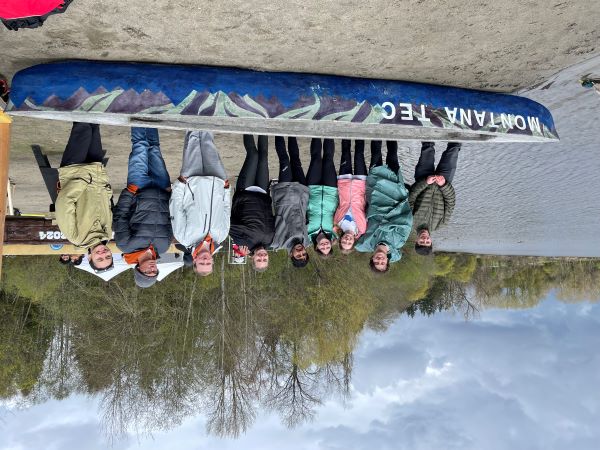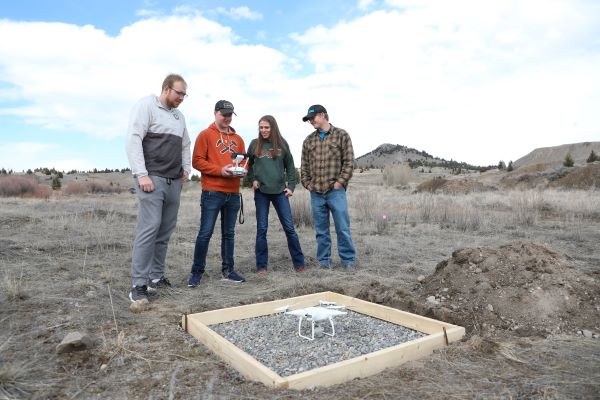Education
Education
Delegation from Kashmir Visiting Montana Tech
A delegation from Kashmir will be visiting Montana Tech’s campus from July 13 to July 19, 2019. The group will include: Dr. Talat Ahmad, vice chancellor of University of Kashmir, Srinagar; Dr. Manzoor Ahmed Shah, botany professor at University of Kashmir, Srinagar; Dr. Zafar Reshi, dean for research at University of Kashmir, Srinagar; Dr. Tanveer Ahmad Shah, special secretary to vice chancellor; and Ms. Uzma Zehra, University of Kashmir student.
The visit is sponsored by the Government of India through a research grant to the University of Kashmir that is collaborative with Montana Tech. Dr. Manzoor Shah is the project leader and Dr. Robert Pal, Montana Tech associate professor in the Biological Sciences Department, is in charge of Montana Tech’s effort. The project is studying and comparing invasive plants in Montana and in Kashmir, which both have high mountains to learn more about the effects of climate change on ecology.
Four lectures will take place at Montana Tech on Monday, July 15th, and Tuesday, July 16th. The presentations are free and open to the public.
“This collaborative research has been proceeding quite well, and we are pleased to host our Kashmiri colleagues. A group from Montana Tech visited them in Kashmir last summer, which was an amazing experience,” said Beverly Hartline. “We are looking forward to their talks and to discussions with them regarding expanding this productive partnership to other fields.”
On Monday, July 15, 2019, at 1:30 p.m. in the Big Butte Conference Room in the Student Union Building, Ahmad will begin with an overview of the University of Kashmir, Srinagar. The world premiere of the documentary, Plant Invaders in Himalaya, will be shown.
At 3:00 p.m., Ahmad will present, "Evolution of the Trans-Himalayan Ladakh Arc, Geochemical and Geochronological Constraints.” The Indus-Tsangpo Suture zone (ITSZ) is considered the collision zone between the Indian and Eurasian plates. Most workers suggest the Himalayan collision occurred between 50 Ma and 45 Ma. New U-Pb zircon data indicate that this switch occurred between 31 Ma and 18 Ma. The collision might be a series of collision-accretion events from 70 Ma to 30 Ma. The upright folding took place at a later time, i.e., mid-Miocene or younger. We also present Argon Isotope data on erosion from the Ladakh Batholith. U-Pb data on detrital zircon from the Karakorum Range indicates the presence of Gondwanic elements considerably north of the Himalayas. These data open a new debate: Where does India end and Eurasia begin?
Professor Talat Ahmad is a vice chancellor of the University of Kashmir and a world-recognized geologist. His research activities span geochemical isotopic, and geochronogic studies especially focused on the Himalayas and the Central Indian Tectonic Zone. He is a Fellow of the Indian National Science Academy of Sciences and the National Academy of Sciences, India. He has published about 100 research papers and supervised 27 Ph.D. students.
On Tuesday, July 16, 2019, at 1:00 pm, in the Chemistry/Biology Building, Room 102 on the Montana Tech campus, Shah will lecture about “Be it Horseweed or Common Reed: Invasion Sucks Indeed." Manzoor A. Shah is an associate professor of botany at the University of Kashmir, Srinagar, J&K, India. His research interest in Himalayan invasive plant species span from molecular-to-macro-ecology, with a primary focus on global patterns of abundance and impacts. He has 70 publications and has recorded numerous honors and awards. He has coordinated several research projects on invasive species, including Indo-German, Indo-Canadian, and Indo-US. He has been a faculty affiliate at UM. Invasive alien species (IAS), which often differ in abundance and impacts in native and non-native ranges, need to be studied biogeographically for understanding such impacts. Here we demonstrate how common reed, Phragmites australis, and Canadian horseweed, Conyza canadensis, vary in abundance, impacts and genetic diversity within and across ranges. Our global scale field studies and controlled experiments revealed that both these species tend to drive out natives in the introduced ranges, but not at home. These species are biased in their competitive effects on species that co-occur with them in native and non-native ranges, suppressing the latter more than former. For instance, P. australis significantly reduces biomass, plant height, and the number of leaves of co-occurring species in non-native ranges than the native ranges. Invasive populations of P. australis showed the highest levels of genetic diversity while the native populations showed the lowest. For C. canadensis, genetic diversity was relatively low and comparable between native and non-native ranges. Eco-physiological basis of variations in the behavior of invasive species and their impacts on key ecosystem functions are discussed. Insights from genetic variations and ecological impacts of two flagship global invaders at a trans-continental scale reiterate the need for integrated efforts worldwide to understand and manage the spread of IAS.
At 1:50 p.m., the world premiere documentary, Plant Invaders in Himalaya, will be shown. At 2:10 p.m., Reshi will present on, Modeling Distribution of Invasive Alien Species Under Changing Climate: A Case Study of Parthenium hysterophorus. Study of shifts in species distribution in response to climate change, particularly for invasive species, using species distribution models is an important research agenda. We used Biomod 2 (an ensemble of 10 algorithms) to model the distribution of a highly invasive species, Parthenium hysterophorus L, under various climate-change scenarios of global, regional (India) and local (J & K State) scales. Suitable niches for P. hysterophorus shrank at global and regional levels under different scenarios, but a reverse trend of niche expansion was predicted at the local (J & K) spacial scale. Further, risk analysis regarding the expansion of Parthenium in India and its Himalayan states is likely to help in the management of this invasive species.
Professor Zafar A. Reshi works at the Department of Botany, University of Kashmir, Srinagar, Jammu & Kashmir, India. His main research interests include the biogeographical perspective of plant invasions, species invasiveness, community invasibility, and distribution modeling of invasive species vis-à-vis climate change. He has published about 150 research papers and book chapters on alien floras of Kashmir Himalaya and India, the biology of some common invasive plant species, biotic homogenization and factors contributing to introduction, establishment, and spread of alien plant species. His leadership has established a vibrant school of invasion biology at the University of Kashmir.
The visit is sponsored by the Government of India through a research grant to the University of Kashmir that is collaborative with Montana Tech. Dr. Manzoor Shah is the project leader and Dr. Robert Pal, Montana Tech associate professor in the Biological Sciences Department, is in charge of Montana Tech’s effort. The project is studying and comparing invasive plants in Montana and in Kashmir, which both have high mountains to learn more about the effects of climate change on ecology.
Four lectures will take place at Montana Tech on Monday, July 15th, and Tuesday, July 16th. The presentations are free and open to the public.
“This collaborative research has been proceeding quite well, and we are pleased to host our Kashmiri colleagues. A group from Montana Tech visited them in Kashmir last summer, which was an amazing experience,” said Beverly Hartline. “We are looking forward to their talks and to discussions with them regarding expanding this productive partnership to other fields.”
On Monday, July 15, 2019, at 1:30 p.m. in the Big Butte Conference Room in the Student Union Building, Ahmad will begin with an overview of the University of Kashmir, Srinagar. The world premiere of the documentary, Plant Invaders in Himalaya, will be shown.
At 3:00 p.m., Ahmad will present, "Evolution of the Trans-Himalayan Ladakh Arc, Geochemical and Geochronological Constraints.” The Indus-Tsangpo Suture zone (ITSZ) is considered the collision zone between the Indian and Eurasian plates. Most workers suggest the Himalayan collision occurred between 50 Ma and 45 Ma. New U-Pb zircon data indicate that this switch occurred between 31 Ma and 18 Ma. The collision might be a series of collision-accretion events from 70 Ma to 30 Ma. The upright folding took place at a later time, i.e., mid-Miocene or younger. We also present Argon Isotope data on erosion from the Ladakh Batholith. U-Pb data on detrital zircon from the Karakorum Range indicates the presence of Gondwanic elements considerably north of the Himalayas. These data open a new debate: Where does India end and Eurasia begin?
Professor Talat Ahmad is a vice chancellor of the University of Kashmir and a world-recognized geologist. His research activities span geochemical isotopic, and geochronogic studies especially focused on the Himalayas and the Central Indian Tectonic Zone. He is a Fellow of the Indian National Science Academy of Sciences and the National Academy of Sciences, India. He has published about 100 research papers and supervised 27 Ph.D. students.
On Tuesday, July 16, 2019, at 1:00 pm, in the Chemistry/Biology Building, Room 102 on the Montana Tech campus, Shah will lecture about “Be it Horseweed or Common Reed: Invasion Sucks Indeed." Manzoor A. Shah is an associate professor of botany at the University of Kashmir, Srinagar, J&K, India. His research interest in Himalayan invasive plant species span from molecular-to-macro-ecology, with a primary focus on global patterns of abundance and impacts. He has 70 publications and has recorded numerous honors and awards. He has coordinated several research projects on invasive species, including Indo-German, Indo-Canadian, and Indo-US. He has been a faculty affiliate at UM. Invasive alien species (IAS), which often differ in abundance and impacts in native and non-native ranges, need to be studied biogeographically for understanding such impacts. Here we demonstrate how common reed, Phragmites australis, and Canadian horseweed, Conyza canadensis, vary in abundance, impacts and genetic diversity within and across ranges. Our global scale field studies and controlled experiments revealed that both these species tend to drive out natives in the introduced ranges, but not at home. These species are biased in their competitive effects on species that co-occur with them in native and non-native ranges, suppressing the latter more than former. For instance, P. australis significantly reduces biomass, plant height, and the number of leaves of co-occurring species in non-native ranges than the native ranges. Invasive populations of P. australis showed the highest levels of genetic diversity while the native populations showed the lowest. For C. canadensis, genetic diversity was relatively low and comparable between native and non-native ranges. Eco-physiological basis of variations in the behavior of invasive species and their impacts on key ecosystem functions are discussed. Insights from genetic variations and ecological impacts of two flagship global invaders at a trans-continental scale reiterate the need for integrated efforts worldwide to understand and manage the spread of IAS.
At 1:50 p.m., the world premiere documentary, Plant Invaders in Himalaya, will be shown. At 2:10 p.m., Reshi will present on, Modeling Distribution of Invasive Alien Species Under Changing Climate: A Case Study of Parthenium hysterophorus. Study of shifts in species distribution in response to climate change, particularly for invasive species, using species distribution models is an important research agenda. We used Biomod 2 (an ensemble of 10 algorithms) to model the distribution of a highly invasive species, Parthenium hysterophorus L, under various climate-change scenarios of global, regional (India) and local (J & K State) scales. Suitable niches for P. hysterophorus shrank at global and regional levels under different scenarios, but a reverse trend of niche expansion was predicted at the local (J & K) spacial scale. Further, risk analysis regarding the expansion of Parthenium in India and its Himalayan states is likely to help in the management of this invasive species.
Professor Zafar A. Reshi works at the Department of Botany, University of Kashmir, Srinagar, Jammu & Kashmir, India. His main research interests include the biogeographical perspective of plant invasions, species invasiveness, community invasibility, and distribution modeling of invasive species vis-à-vis climate change. He has published about 150 research papers and book chapters on alien floras of Kashmir Himalaya and India, the biology of some common invasive plant species, biotic homogenization and factors contributing to introduction, establishment, and spread of alien plant species. His leadership has established a vibrant school of invasion biology at the University of Kashmir.



